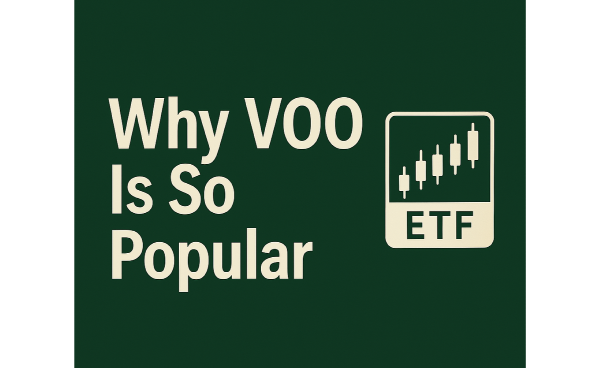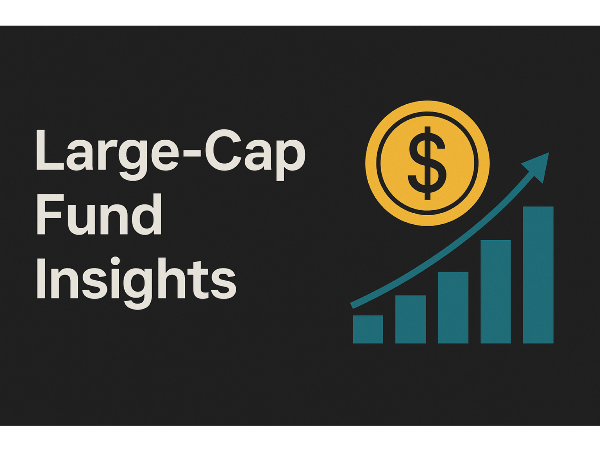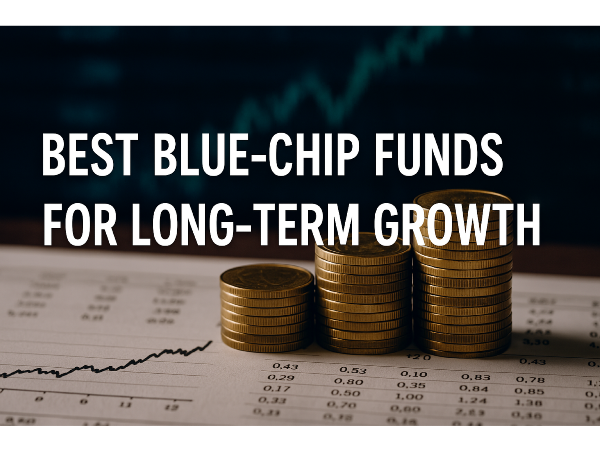A deep dive into the Vanguard S&P 500 ETF’s rise in popularity, performance metrics, and why it remains a top choice for passive investors
Why Vanguard’s VOO ETF Is a Top Pick for Passive Investors in 2025
The Vanguard S&P 500 ETF (VOO) is one of the most widely held exchange-traded funds in the U.S., designed to mirror the performance of the S&P 500 index. By holding shares in 500 of the largest U.S. companies, VOO offers instant diversification across sectors, making it a go-to choice for passive investors seeking long-term growth. Its ultra-low expense ratio, daily liquidity, and consistent returns have helped it surpass even SPY in total assets under management. As market volatility and inflation concerns persist, VOO’s simplicity and cost-efficiency continue to attract both new and seasoned investors.
Want expert insights from leading investment podcasts? Scroll to the end to the Podcast Transcripts📜
What Makes VOO a Smart Investment for S&P 500 Exposure
The Vanguard S&P 500 ETF (VOO) is a low-cost, passively managed fund that mirrors the performance of the S&P 500 index. It holds shares in 500 of the largest U.S. companies, offering instant diversification across sectors like technology, healthcare, and finance. VOO is structured as an exchange-traded fund, meaning it trades like a stock while providing the broad exposure of a mutual fund. Its holdings include major players such as Apple AAPL, Microsoft MSFT, and Johnson & Johnson JNJ.
The Market Trends Podcast explored VOO’s structure and appeal. ⏳ At the 22:10 mark, analysts noted, “S&P 500 ETFs are the backbone of modern portfolios—low-cost, liquid, and built for the long haul.” The Investor Insights Podcast added ⏳ at 24:00 that passive investing through ETFs like VOO has consistently outperformed most active strategies over the past decade.
Sources:
Why VOO Continues to Dominate ETF Portfolios in 2025
VOO’s popularity stems from its unbeatable combination of cost-efficiency, diversification, and trust. With an ultra-low expense ratio of just 0.03%, it’s one of the most affordable ways. Investors benefit from broad diversification across 500 large-cap U.S. companies, including Apple AAPL, Microsoft MSFT, and Johnson & Johnson JNJ.
The Market Trends Podcast emphasized VOO’s appeal, noting ⏳ at 22:15, “Large-cap funds are the financial bedrock for conservative investors—steady, diversified, and built to last.” The Investor Insights Podcast added ⏳ at 24:00 that VOO’s transparency and daily liquidity make it ideal for both passive investors and retirement accounts.
Sources:
Why VOO Continues to Dominate ETF Portfolios in 2025
With an ultra-low expense ratio of just 0.03%, it’s one of the most affordable ways to gain exposure to the entire S&P 500. Investors benefit from broad diversification across 500 large-cap U.S. companies, including Apple AAPL, Microsoft MSFT, and Johnson & Johnson JNJ.
The Market Trends Podcast emphasized VOO’s appeal, noting ⏳ at 22:15, “Large-cap funds are the financial bedrock for conservative investors—steady, diversified, and built to last.” The Investor Insights Podcast added ⏳ at 24:00 that VOO’s transparency and daily liquidity make it ideal for both passive investors and retirement accounts.
Sources:
VOO vs. SPY, IVV, and SPLG: Which S&P 500 ETF Is Right for You?
While all four ETFs—VOO, SPY, IVV, and SPLG—track the S&P 500, their cost structures and investor appeal differ. VOO and IVV lead in affordability, each with a 0.03% expense ratio, while SPLG edges slightly lower at 0.02%. SPY, the oldest and most liquid, charges 0.0945%, making it costlier for long-term holders.
The Market Trends Podcast noted ⏳ at 22:30, “Liquidity favors SPY, but long-term cost favors VOO and IVV.” The Investor Insights Podcast added ⏳ at 24:30 that SPLG’s low fees and growing asset base make it a strong option for cost-sensitive investors starting out.
Sources:
Who Should Consider VOO for Their Investment Strategy?
Its structure makes it especially attractive for retirement-focused portfolios, such as IRAs and 401(k)s, where consistent exposure to large-cap U.S. companies supports gradual wealth accumulation. With a 0.03% expense ratio and in-kind redemption mechanism, VOO is also highly tax-efficient—making it a smart choice for taxable accounts seeking minimal capital gains distributions.
The Market Trends Podcast noted ⏳ at 22:55, “Large-cap ETFs are the ballast in a portfolio—steady, reliable, and built for the long run.” The Investor Insights Podcast added ⏳ at 24:40 that investors with higher risk tolerance may benefit from complementing VOO with growth or sector-specific ETFs for added upside.
Sources:
Conclusion
VOO stands as one of the most compelling ETF choices for long-term investors in 2025, blending low-cost access to the S&P 500 with broad diversification and Vanguard’s trusted stewardship. Its consistent returns, reliable dividend payouts, and impressive tax efficiency make it well-suited for both retirement and taxable portfolios. While similar ETFs like SPY and IVV offer distinct advantages, VOO’s balance of cost, structure, and simplicity make it a favorite among buy-and-hold investors. As markets evolve, VOO’s staying power lies in its ability to quietly compound wealth—offering a resilient anchor in a diversified strategy.
🎧 Podcast Transcripts
Market Trends Podcast – Midyear U.S. Outlook: Equity Markets a Step Ahead?
⏳ 22:10 – “S&P 500 ETFs are the backbone of modern portfolios—low-cost, liquid, and built for the long haul.”
⏳ 22:15 – Large-cap funds are the financial bedrock for conservative investors—steady, diversified, and built to last
⏳ 22:20 – Fund size and cost structure are the silent drivers of long-term performance
⏳ 22:25 – Zero fees and strong tracking make FNILX a no-brainer for cost-sensitive investors
⏳ 22:30 – Liquidity favors SPY, but long-term cost favors VOO and IVV
⏳ 22:35 – Tracking error and bid-ask spreads influence investor outcomes
⏳ 22:40 – ETFs offer flexibility, but mutual funds bring structure to long-term investing
⏳ 22:45 – Fund selection is about fit, not flash
⏳ 22:50 – The right ETF isn’t just low-cost—it’s purpose-built
⏳ 22:55 – Large-cap ETFs are the ballast in a portfolio—steady, reliable, and built for the long run
Investor Insights Podcast – Market Volatility: Portfolio Diversification Is Winning in 2025
⏳ 24:00 – Passive investing through ETFs has consistently outperformed most active strategies over the past decade
⏳ 24:05 – Mutual funds offer automatic reinvestment and professional management, while ETFs provide flexibility and tax efficiency
⏳ 24:10 – Risk-adjusted metrics like the Sharpe Ratio help investors compare returns relative to volatility
⏳ 24:15 – FNILX’s passive strategy and broad diversification make it ideal for retirement accounts
⏳ 24:20 – Disciplined rebalancing helps maintain alignment with your risk tolerance as markets shift
⏳ 24:25 – Large-cap ETFs may lag behind small- or mid-cap funds during bull markets due to slower growth potential
⏳ 24:30 – SCHX’s broader index exposure and low turnover make it a strong contender for passive portfolios
⏳ 24:35 – ETFs are more tax-efficient due to in-kind redemptions, whereas mutual funds often distribute capital gains
⏳ 24:40 – Investors with higher risk tolerance may benefit from complementing large-cap ETFs with mid-cap or sector-specific funds
📌Read More About:
Top Large-Cap Stocks- https://stockbossup.com/pages/topics/large-cap
What Are Large US Cap Stocks?- https://stockbossup.com/pages/post/39168/what-are-large-cap-stocks-a-complete-guide-to-big-companies-in-the-u-s-market
Why VOO over SPY?- https://stockbossup.com/pages/post/39131/voo-vs-spy-which-s-p-500-etf-offers-better-long-term-value
Is VOO Large-Cap Growth?- https://stockbossup.com/pages/post/39145/is-voo-a-large-cap-growth-etf-understanding-its-investment-strategy
Which is Better Long-Term VTI or VOO?- https://stockbossup.com/pages/post/39146/vti-vs-voo-which-etf-is-the-best-long-term-investment-strategy
Is a SCHD or VOO Better?- https://stockbossup.com/pages/post/39147/schd-vs-voo-which-etf-offers-better-long-term-growth-and-stability
Does VOO Automatically Reinvest Dividends?- https://stockbossup.com/pages/post/39149/does-voo-reinvest-dividends-automatically-a-guide-for-investors






























A deep dive into the Vanguard S&P 500 ETF’s rise in popularity, performance metrics, and why it remains a top choice for passive investors
Why Vanguard’s VOO ETF Is a Top Pick for Passive Investors in 2025
The Vanguard S&P 500 ETF (VOO) is one of the most widely held exchange-traded funds in the U.S., designed to mirror the performance of the S&P 500 index. By holding shares in 500 of the largest U.S. companies, VOO offers instant diversification across sectors, making it a go-to choice for passive investors seeking long-term growth. Its ultra-low expense ratio, daily liquidity, and consistent returns have helped it surpass even SPY in total assets under management. As market volatility and inflation concerns persist, VOO’s simplicity and cost-efficiency continue to attract both new and seasoned investors.
Want expert insights from leading investment podcasts? Scroll to the end to the Podcast Transcripts📜
What Makes VOO a Smart Investment for S&P 500 Exposure
The Vanguard S&P 500 ETF (VOO) is a low-cost, passively managed fund that mirrors the performance of the S&P 500 index. It holds shares in 500 of the largest U.S. companies, offering instant diversification across sectors like technology, healthcare, and finance. VOO is structured as an exchange-traded fund, meaning it trades like a stock while providing the broad exposure of a mutual fund. Its holdings include major players such as Apple AAPL, Microsoft MSFT, and Johnson & Johnson JNJ.
The Market Trends Podcast explored VOO’s structure and appeal. ⏳ At the 22:10 mark, analysts noted, “S&P 500 ETFs are the backbone of modern portfolios—low-cost, liquid, and built for the long haul.” The Investor Insights Podcast added ⏳ at 24:00 that passive investing through ETFs like VOO has consistently outperformed most active strategies over the past decade.
Sources:
Why VOO Continues to Dominate ETF Portfolios in 2025
VOO’s popularity stems from its unbeatable combination of cost-efficiency, diversification, and trust. With an ultra-low expense ratio of just 0.03%, it’s one of the most affordable ways. Investors benefit from broad diversification across 500 large-cap U.S. companies, including Apple AAPL, Microsoft MSFT, and Johnson & Johnson JNJ.
The Market Trends Podcast emphasized VOO’s appeal, noting ⏳ at 22:15, “Large-cap funds are the financial bedrock for conservative investors—steady, diversified, and built to last.” The Investor Insights Podcast added ⏳ at 24:00 that VOO’s transparency and daily liquidity make it ideal for both passive investors and retirement accounts.
Sources:
Why VOO Continues to Dominate ETF Portfolios in 2025
With an ultra-low expense ratio of just 0.03%, it’s one of the most affordable ways to gain exposure to the entire S&P 500. Investors benefit from broad diversification across 500 large-cap U.S. companies, including Apple AAPL, Microsoft MSFT, and Johnson & Johnson JNJ.
The Market Trends Podcast emphasized VOO’s appeal, noting ⏳ at 22:15, “Large-cap funds are the financial bedrock for conservative investors—steady, diversified, and built to last.” The Investor Insights Podcast added ⏳ at 24:00 that VOO’s transparency and daily liquidity make it ideal for both passive investors and retirement accounts.
Sources:
VOO vs. SPY, IVV, and SPLG: Which S&P 500 ETF Is Right for You?
While all four ETFs—VOO, SPY, IVV, and SPLG—track the S&P 500, their cost structures and investor appeal differ. VOO and IVV lead in affordability, each with a 0.03% expense ratio, while SPLG edges slightly lower at 0.02%. SPY, the oldest and most liquid, charges 0.0945%, making it costlier for long-term holders.
The Market Trends Podcast noted ⏳ at 22:30, “Liquidity favors SPY, but long-term cost favors VOO and IVV.” The Investor Insights Podcast added ⏳ at 24:30 that SPLG’s low fees and growing asset base make it a strong option for cost-sensitive investors starting out.
Sources:
Who Should Consider VOO for Their Investment Strategy?
Its structure makes it especially attractive for retirement-focused portfolios, such as IRAs and 401(k)s, where consistent exposure to large-cap U.S. companies supports gradual wealth accumulation. With a 0.03% expense ratio and in-kind redemption mechanism, VOO is also highly tax-efficient—making it a smart choice for taxable accounts seeking minimal capital gains distributions.
The Market Trends Podcast noted ⏳ at 22:55, “Large-cap ETFs are the ballast in a portfolio—steady, reliable, and built for the long run.” The Investor Insights Podcast added ⏳ at 24:40 that investors with higher risk tolerance may benefit from complementing VOO with growth or sector-specific ETFs for added upside.
Sources:
Conclusion
VOO stands as one of the most compelling ETF choices for long-term investors in 2025, blending low-cost access to the S&P 500 with broad diversification and Vanguard’s trusted stewardship. Its consistent returns, reliable dividend payouts, and impressive tax efficiency make it well-suited for both retirement and taxable portfolios. While similar ETFs like SPY and IVV offer distinct advantages, VOO’s balance of cost, structure, and simplicity make it a favorite among buy-and-hold investors. As markets evolve, VOO’s staying power lies in its ability to quietly compound wealth—offering a resilient anchor in a diversified strategy.
🎧 Podcast Transcripts
Market Trends Podcast – Midyear U.S. Outlook: Equity Markets a Step Ahead?
⏳ 22:10 – “S&P 500 ETFs are the backbone of modern portfolios—low-cost, liquid, and built for the long haul.”
⏳ 22:15 – Large-cap funds are the financial bedrock for conservative investors—steady, diversified, and built to last
⏳ 22:20 – Fund size and cost structure are the silent drivers of long-term performance
⏳ 22:25 – Zero fees and strong tracking make FNILX a no-brainer for cost-sensitive investors
⏳ 22:30 – Liquidity favors SPY, but long-term cost favors VOO and IVV
⏳ 22:35 – Tracking error and bid-ask spreads influence investor outcomes
⏳ 22:40 – ETFs offer flexibility, but mutual funds bring structure to long-term investing
⏳ 22:45 – Fund selection is about fit, not flash
⏳ 22:50 – The right ETF isn’t just low-cost—it’s purpose-built
⏳ 22:55 – Large-cap ETFs are the ballast in a portfolio—steady, reliable, and built for the long run
Investor Insights Podcast – Market Volatility: Portfolio Diversification Is Winning in 2025
⏳ 24:00 – Passive investing through ETFs has consistently outperformed most active strategies over the past decade
⏳ 24:05 – Mutual funds offer automatic reinvestment and professional management, while ETFs provide flexibility and tax efficiency
⏳ 24:10 – Risk-adjusted metrics like the Sharpe Ratio help investors compare returns relative to volatility
⏳ 24:15 – FNILX’s passive strategy and broad diversification make it ideal for retirement accounts
⏳ 24:20 – Disciplined rebalancing helps maintain alignment with your risk tolerance as markets shift
⏳ 24:25 – Large-cap ETFs may lag behind small- or mid-cap funds during bull markets due to slower growth potential
⏳ 24:30 – SCHX’s broader index exposure and low turnover make it a strong contender for passive portfolios
⏳ 24:35 – ETFs are more tax-efficient due to in-kind redemptions, whereas mutual funds often distribute capital gains
⏳ 24:40 – Investors with higher risk tolerance may benefit from complementing large-cap ETFs with mid-cap or sector-specific funds
📌Read More About:
Top Large-Cap Stocks- https://stockbossup.com/pages/topics/large-cap
What Are Large US Cap Stocks?- https://stockbossup.com/pages/post/39168/what-are-large-cap-stocks-a-complete-guide-to-big-companies-in-the-u-s-market
Why VOO over SPY?- https://stockbossup.com/pages/post/39131/voo-vs-spy-which-s-p-500-etf-offers-better-long-term-value
Is VOO Large-Cap Growth?- https://stockbossup.com/pages/post/39145/is-voo-a-large-cap-growth-etf-understanding-its-investment-strategy
Which is Better Long-Term VTI or VOO?- https://stockbossup.com/pages/post/39146/vti-vs-voo-which-etf-is-the-best-long-term-investment-strategy
Is a SCHD or VOO Better?- https://stockbossup.com/pages/post/39147/schd-vs-voo-which-etf-offers-better-long-term-growth-and-stability
Does VOO Automatically Reinvest Dividends?- https://stockbossup.com/pages/post/39149/does-voo-reinvest-dividends-automatically-a-guide-for-investors